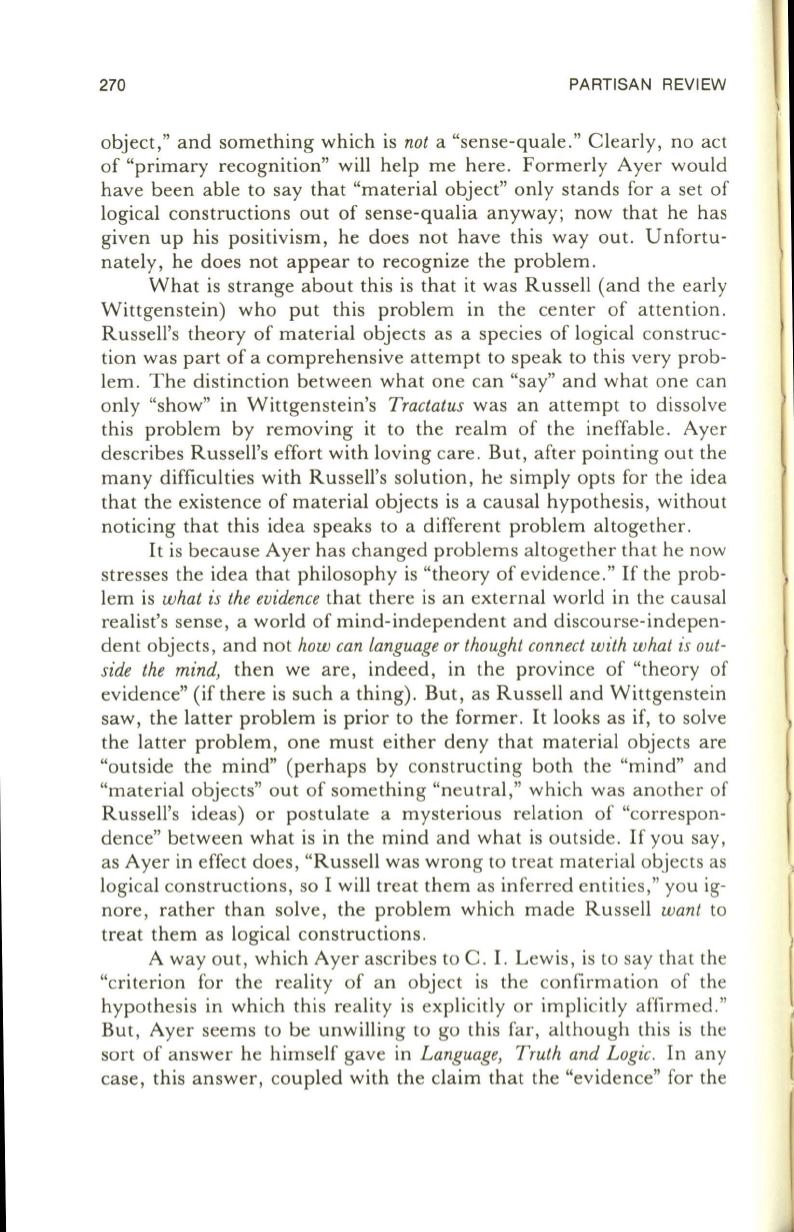
270
PARTISAN REVIEW
object," and something which is
not
a "sense-quale ." Clearly, no act
of "primary recognition" will help me here. Formerly Ayer would
have been able to say that "material object" only stands for a set of
logical constructions out of sense-qualia anyway; now that he has
given up his positivism, he does not have this way out. U nfortu–
nately, he does not appear to recognize the problem.
What is strange about this is that it was Russell (and the early
Wittgenstein) who put this problem in the center of attention .
Russell's theory of material objects as a species of logical construc–
tion was part of a comprehensive attempt to speak to this very prob–
lem. The distinction between what one can "say" and what one can
only "show" in Wittgenstein's
Tractatus
was an attempt to dissolve
this problem by removing it to the realm of the ineffable. Ayer
describes Russell's effort with loving care. But, after pointing out the
many difficulties with Russell's solution, he simply opts for the idea
that the existence of material objects is a causal hypothesis, without
noticing that this idea speaks to a different problem altogether.
It
is because Ayer has changed problems altogether that he now
stresses the idea that philosophy is "theory of evidence."
If
the prob–
lem is
what is the evidence
that there is an external world in the causal
realist's sense, a world of mind-independent and discourse-indepen–
dent objects, and not
how can language or thought connect with what is out–
side the mind,
then we are, indeed, in the province of "theory of
evidence" (if there is such a thing). But, as Russell and Wittgenstein
saw, the latter problem is prior to the former. It looks as if, to solve
the latter problem, one must either deny that material objects are
"outside the mind" (perhaps by constructing both the "mind" and
"material objects" out of something "neutral," which was another of
Russell's ideas) or postulate a mysterious relation of "correspon–
dence" between what is in the mind and what is outside .
If
you say,
as Ayer in effect does, "Russell was wrong to treat material objects as
logical constructions, so I will treat them as inferred entities," you ig–
nore , rather than solve, the problem which made Russell
want
to
treat them as logical constructions.
A way out, which Ayer ascribes to C .
I.
Lewis, is to say that the
"criterion for the reality of an object is the confirmation of the
hypothesis in which this reality is explicitly or implicitly affirmed ."
But, Ayer seems to be unwilling to go this far, although this is the
sort of answer he himself gave in
Language, Truth and Logic.
In any
case, this answer, coupled with the claim that the "evidence" for the


